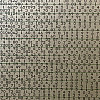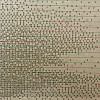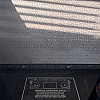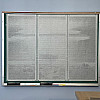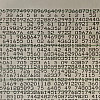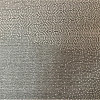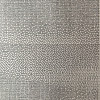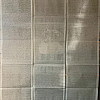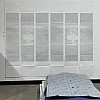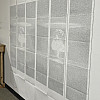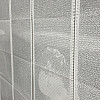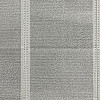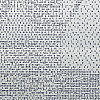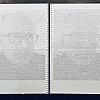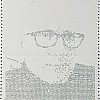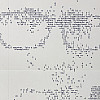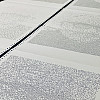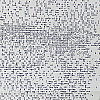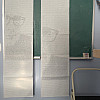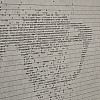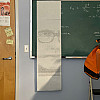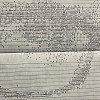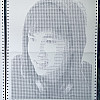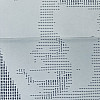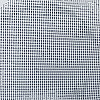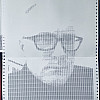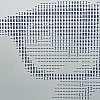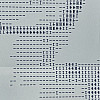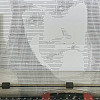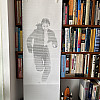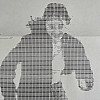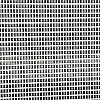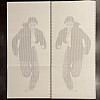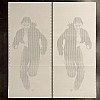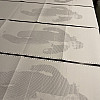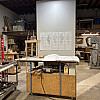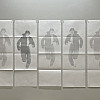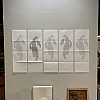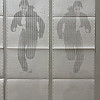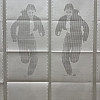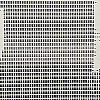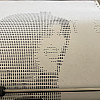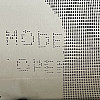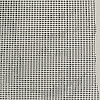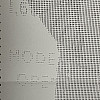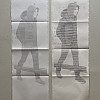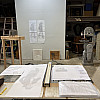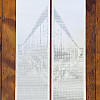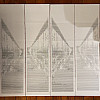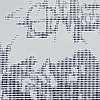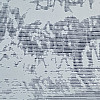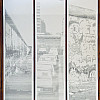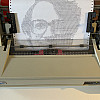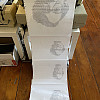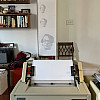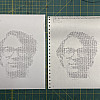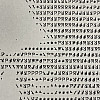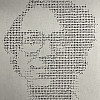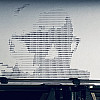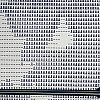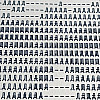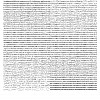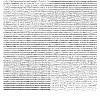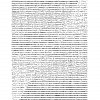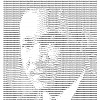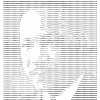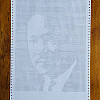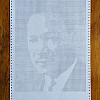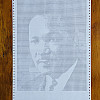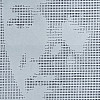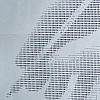ASCIIArt
Images are rendered in single-strike and double-strike type using a variety of typefaces. Glyphs are selected to map the grayscale intensity of an image to letters or letter combinations. Double-striking uses a carriage return without a linefeed to print one line of type over the other. This operation is a capability of many hardcopy printers and teleprinters, and was also used in Richard Williams' Art1 program.
Irrational calculation
sqrt(7)
The first 51207 digits of sqrt(7) create a dithered image of the 1954 Castle Bravo nuclear test.
Printronix P300 line matrix printer on 14 7/8" x 11" 15 lb. tri-perforated continuous computer paper with green lines. (8 lines per inch, 132 columns)
April 2024
sqrt(5)
123415 digits of sqrt(5) create a dithered image of the 1954 Castle Romeo nuclear test.
Printronix P300 line matrix printer on 14 7/8" x 11" 15 lb. tri-perforated continuous computer paper with green lines. (8 lines per inch, 132 columns)
May 2024
2sqrt(5)
Digits of sqrt(5) create dithered images of the 1954 Castle Romeo nuclear test.
Printronix P300 line matrix printer on 14 7/8" x 11" 15 lb. tri-perforated continuous computer paper with green lines. (8 lines per inch, 132 columns)
May 2024
The Irrational series is a play on calculations that blow up. Like many of my projects, these pieces are an opportunity to craft and run small programs. In this case, I use codes that generate many digits of irrational numbers with a "spigot" algorithm. [1] I then distribute the numbers according to a dithered image. A modern laptop can generate tens of thousands, even hundreds of thousands of digits in just a minute or two. The number-generating code churns along in a deterministic fashion. But the resulting image that these numbers form -- that of a thermonuclear explosion thousands of times larger than the bomb used at Hiroshima -- is one of devastation and tenuous geo-political stability that has the potential to rapidly, explosively, escalate -- to diverge in the mathematical sense.
Our computer codes and machines are the direct descendants of the first computers -- among them, John von Neumann's creations with his team at the Institute for Advanced Study. Early computers were quickly put to use modeling and designing nuclear weapons. [2] Los Alamos became a central location in the development of general, programmable computers. Bomb designers used them to analyze physical models with numerical calculations. The advent of numerical methods, finite difference equations, and even probabilistic sampling methods like Monte Carlo, were the work of Manhattan Project scientists during and then after the war. Metropolis, von Neumann, Teller, Frankel, and others were prime movers in the burgeoning field of computer engineering and computational methods.
A closer inspection of the Irrational images reveals shifting and unsteady rows and columns of numbers -- some grouped together, others clustered; some detached and floating alone in open space. The numbers could represent the frenetic output of a machine intelligence gone mad, a corrupted spreadsheet from the Cold War techno-bureaucracy, or simply a glitchy computer continuing on in its endless calculation that some forgotten operator started long ago -- a lasting relic, like our aging but persistent arsenals of weapons of mass destruction. The images are captured on another artifact -- reams of continuous feed computer paper -- evoking a time when interaction with computers came largely through the printed output of batch-processed jobs.
These text mode images and portraits are process-oriented, rather than generative or "permutational," a word coined by Abraham Moles to describe the combinatoric capacity of computational art. I am not using the computer to explore the schema of all drawings, as Frieder Nake proposed. [3] My explorations are methodical and deterministic, like the calculations themselves. In this context, the computer becomes a machine or device that helps me process an idea. What interests me here is the resulting juxtaposition of different representations: an irrational number taking the form of Edward Teller's seemingly mad fixation on the hunt for powerful thermonuclear weapons -- both made possible through the development of the high-speed electronic computer; the pointless precision (from an engineering or scientific perspective) of a number calculated to tens or hundreds of thousands of digits against the futility of knowing the whole of its decimal expansion.
- S. Rabinowitz, Abstract 863-11-482: A spigot algorithm for π, Abstracts Amer. Math. Society 12 (1991) p. 30; S. Rabinowitz, S. Wagon, A Spigot Algorithm for the Digits of π, The American Mathematical Monthly, Vol. 102, No. 3. (Mar., 1995), pp. 195-203. See also: Pi Prints
- Dyson, George. Turing's Cathedral. Penguin: New York, 1992.
- "... the traditional artist deals with the one drawing. The programmer describes the schema of all of the drawings." Frieder Nake quoted by Leslie Jones, Introduction: Still Processing. In Coded: Art Enters the Computer Age, 1952-1982. Los Angeles County Museum of Art: Los Angeles, 2023.
Coded
Text mode self-portraits rendered in the program code used to generate the images. A changing contrast shifts the balance between self-image and code. Rather than using grayscale, images are binarized and dithered using the Floyd-Steinberg algorithm. Printed using a wide format Qume Sprint 11/55 daisywheel printer with a Prestige Elite 12 ASCII 96 typewheel on 14 7/8" x 11" 20 lb. tri-perforated continuous computer paper.
January 2024
A second series with more disorder caused by resampling the image size after binarization.
Printed using a Printronix P300 line matrix printer on 14 7/8" x 11" 15 lb. tri-perforated continuous computer paper with green lines. (6 lines per inch, 132 columns)
April 2024
Wide Styles
Portraits in overstriking characters using a Courier 10 typeface rendered on a wide format Qume Sprint 11/55 daisywheel printer on green-bar Universal UNV15852 Computer Paper, 20lb, 14-7/8” x 11”, perforated, using the blank side. The limited palette of characters, -=IH, is inspired by the textures in Frederick Hammerley's "The Same Change" and gives the images a crosshatching quality.
August 2021
C RUN
October 2021
August 2022
BANCSII
October 2021
August 2022
GATE
Images of the Berlin Wall and Brandenburg Gate taken in August 1989 arranged as a triptych.
October 2021
POLYPTYCH
Images of the Berlin Wall taken in August 1989 arranged in polyptychs.
October 2021
DIE MAUER
Images of the Berlin Wall taken in August 1989.
October 2021
PJW
PJW banner, Prestige Elite 12 typeface rendered on a wide format Qume Sprint 11/55 daisywheel printer, green-bar Universal UNV15852 Computer Paper, 20lb, 14-7/8” x 11”, perforated, using the blank side
February 2022
PJW images printed on Teletype Model 33 ASR and Olivetti Te-318 teleprinters
February 2022
КОИ-7 AРT
Russian Cubic 10 typeface printed on a Diablo Advantage D-25, green-bar Universal UNV15852 Computer Paper, 20lb, 14-7/8” x 11”, perforated, using the blank side
July 2021
Russian Cubic 10 typeface printed on wide format Qume Sprint 11/55 daisywheel printer
February 2022
Overstrikes
Studies of overstriking ASCII-63 glyphs arranged in opposing gradients and rendered with Olivettize.
January 2021
Martin Luther King Jr.
Portrait of the American civil rights leader in two ASCII-63 palettes and rendered with Olivettize.
January 2021
MLK in four variations
Courier 10 typeface, Qume Sprint 11/55 printer, green-bar Universal UNV15852 Computer Paper, 20lb, 14-7/8” x 11”, perforated, using the blank side
August 2022
HANDSCII
Courier 10 typeface, Qume Sprint 11/55 printer, green-bar Universal UNV15852 Computer Paper, 20lb, 14-7/8” x 11”, perforated, using the blank side
August 2022
Hand holding a mechanical pencil and rendered with Olivettize.
December 2020
References
- Macleod, I. D. G., Pictorial Output with a Line Printer, IEEE Transactions on Computers, C-19, 160--162 (1970). DOI:10.1109/T-C.1970.222883


